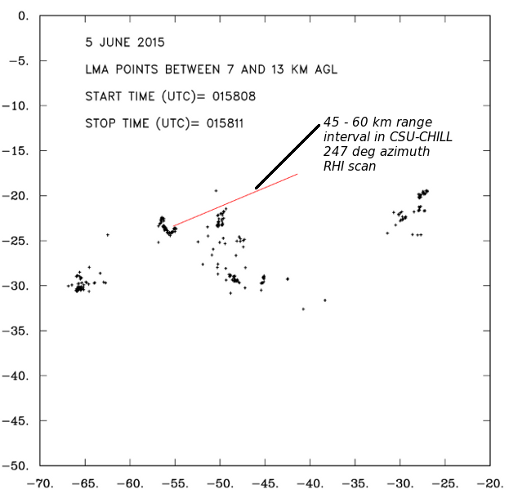DPWX/Dual-polarization radar indications of ice crystal canting due to electric fields: 5 June 2015: Difference between revisions
Pat kennedy (talk | contribs) (Initial posting for Oct 2015) |
Pat kennedy (talk | contribs) No edit summary |
||
| Line 1: | Line 1: | ||
==Overview== | |||
The CSU-CHILL radar conducted low elevation angle PPI scans for precipitation mapping purposes during an outbreak of severe weather in the evening hours of 4 June 2015 (5 June on UTC). A few RHI scans were also conducted. In one such RHI sweep near 0158 UTC, several of the dual-polarization data fields contained evidence of ice crystal re-orientation due to electric field effects. The aerodynamic forces acting on planar ice crystals tend to keep the crystal's major axis in a quasi-horizontal orientation as they fall towards the ground. This preferred crystal orientation can be altered by sufficiently strong external electric fields. The charge dipole structure in the water molecules composing the ice crystal structure causes these cloud particles to tend to rotate into alignment with the lines of the external electric field. Thus, areas where dual polarization radar data indicate that the average ice crystal orientation has been appreciably altered from the horizontal probably contain strong electric fields. The development of lightning discharges is favored in these high electric field strength areas. | |||
==KFTG data== | |||
Since the CSU-CHILL radar was not scanning at high elevation angles, data collected by the NWS KFTG radar located near Denver, Colorado was examined to provide an overview of the echo situation. The following plot shows the KFTG reflectivity pattern in the 6.4 degree elevation angle sweep at ~0156:30 UTC. The highlighted 35 and 55 dBZ contours identify the thunderstorm cores of interest. The orientation of the CSU-CHILL RHI scan done near 0158 UTC is also marked. This RHI scan intercepted portions of the storm centered at X= -58, Y= 47 km from KFTG. (Red-colored portion of the RHI line). The KFTG beam height in the vicinity of this storm is ~XX km MSL. | |||
[[Image:KFTG 5jun2015 0156 Z PPI anot.png|center]] | [[Image:KFTG 5jun2015 0156 Z PPI anot.png|center]] | ||
The following plot shows the differential reflectivity (Zdr) data in the same KFTG sweep. The NWS WSR-88DP radars make dual polarization measurements by simultaneously transmitting horizontally and vertically polarized pulses (VHS operating mode). Coupling between the returns of the H and V waves will occur when these VHS transmissions propagate through non-spherical hydrometeors that are oriented with a preferred canting angle (Ref). As ice crystal orientations rotate towards the vertical, the VHS mode coupling produces radially-oriented stripes of enhanced positive and negative Zdr values (Ref 2). | |||
[[Image:KFTG 5jun2015 0156 Zdr anot.png|center]] | [[Image:KFTG 5jun2015 0156 Zdr anot.png|center]] | ||
==CSU-CHILL RHI data== | |||
The next two plots show the basic reflectivity and radial velocity patterns observed in the the 247 degree azimuth RHI conducted by the CSU-CHILL radar approximately two minutes after the KFTG sweep shown above. The reflectivity data indicated that the echo summit approached 14 km AGL (15.4 km MSL) near the 55 km range. | |||
[[Image:5jun2015 0158 Z rhi.png|center]] | [[Image:5jun2015 0158 Z rhi.png|center]] | ||
The corresponding radial velocity field contained strong storm-top divergence. It can be inferred that this divergence was driven by the interaction of an intense updraft with the increasing static stability at the tropopause. This updraft provided an environment in which ice particle collisions occurred in the presence of supercooled water droplets; a regime where the non-inductive charging process was probably active. | |||
[[Image:5jun2015 0158 VT rhi.png|center]] | [[Image:5jun2015 0158 VT rhi.png|center]] | ||
Selected dual polarization fields from this RHI scan have been collected into the following image loop sequence. Instead of a continuous animation, it is recommended that the "next" button be used to step through the images. The CSU-CHILL polarimetric data was collected using the alternating polarization mode (H polarized pulse followed by a V polarized pulse) vs. the VHS method employed by KFTG. This alternating operating mode is not affected by cross coupling. The CHILL Zdr field is relatively featureless in the sub-freezing portions of the echo. The effects of the oriented ice crystals are masked by the larger diameter, higher reflectivity, quasi-spherical (~0 dB Zdr) aggregated ice particles. In contrast to Zdr, specific propagation differential phase is sensitive to the presence of oriented, non-spherical hydrometeors. As the mean ice crystal orientation becomes quasi-vertical due to electric field effects, the propagation of the V waves is slowed relative to the H wave speed. This difference leads to the fractionally negative Kdp values that were observed above ~ 6 km AGL. Enhanced Linear Depolarization Ratio (LDR) values were detected at somewhat greater heights (i.e., above ~8.5 km AGL). LDR is maximized when the hydrometeor's major axis is rotated to 45 degrees since this angle most effectively backscatters incident H waves into the V cross=polar polarization. | |||
[[Image:5jun2015 PCK LMA anot V2.png|center]] | [[Image:5jun2015 PCK LMA anot V2.png|center]] | ||
Revision as of 05:20, 29 September 2015
Overview
The CSU-CHILL radar conducted low elevation angle PPI scans for precipitation mapping purposes during an outbreak of severe weather in the evening hours of 4 June 2015 (5 June on UTC). A few RHI scans were also conducted. In one such RHI sweep near 0158 UTC, several of the dual-polarization data fields contained evidence of ice crystal re-orientation due to electric field effects. The aerodynamic forces acting on planar ice crystals tend to keep the crystal's major axis in a quasi-horizontal orientation as they fall towards the ground. This preferred crystal orientation can be altered by sufficiently strong external electric fields. The charge dipole structure in the water molecules composing the ice crystal structure causes these cloud particles to tend to rotate into alignment with the lines of the external electric field. Thus, areas where dual polarization radar data indicate that the average ice crystal orientation has been appreciably altered from the horizontal probably contain strong electric fields. The development of lightning discharges is favored in these high electric field strength areas.
KFTG data
Since the CSU-CHILL radar was not scanning at high elevation angles, data collected by the NWS KFTG radar located near Denver, Colorado was examined to provide an overview of the echo situation. The following plot shows the KFTG reflectivity pattern in the 6.4 degree elevation angle sweep at ~0156:30 UTC. The highlighted 35 and 55 dBZ contours identify the thunderstorm cores of interest. The orientation of the CSU-CHILL RHI scan done near 0158 UTC is also marked. This RHI scan intercepted portions of the storm centered at X= -58, Y= 47 km from KFTG. (Red-colored portion of the RHI line). The KFTG beam height in the vicinity of this storm is ~XX km MSL.
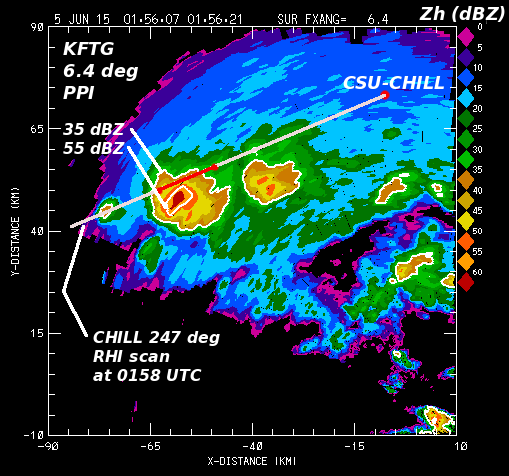
The following plot shows the differential reflectivity (Zdr) data in the same KFTG sweep. The NWS WSR-88DP radars make dual polarization measurements by simultaneously transmitting horizontally and vertically polarized pulses (VHS operating mode). Coupling between the returns of the H and V waves will occur when these VHS transmissions propagate through non-spherical hydrometeors that are oriented with a preferred canting angle (Ref). As ice crystal orientations rotate towards the vertical, the VHS mode coupling produces radially-oriented stripes of enhanced positive and negative Zdr values (Ref 2).
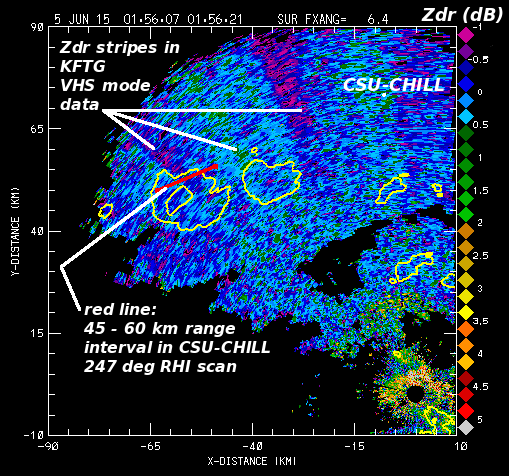
CSU-CHILL RHI data
The next two plots show the basic reflectivity and radial velocity patterns observed in the the 247 degree azimuth RHI conducted by the CSU-CHILL radar approximately two minutes after the KFTG sweep shown above. The reflectivity data indicated that the echo summit approached 14 km AGL (15.4 km MSL) near the 55 km range.
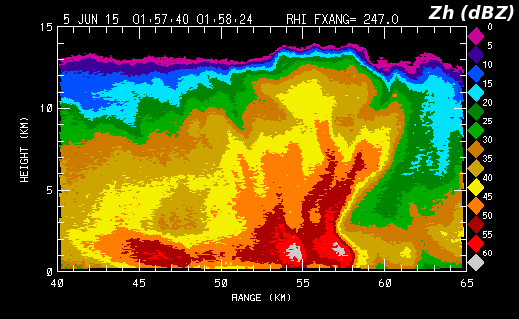
The corresponding radial velocity field contained strong storm-top divergence. It can be inferred that this divergence was driven by the interaction of an intense updraft with the increasing static stability at the tropopause. This updraft provided an environment in which ice particle collisions occurred in the presence of supercooled water droplets; a regime where the non-inductive charging process was probably active.
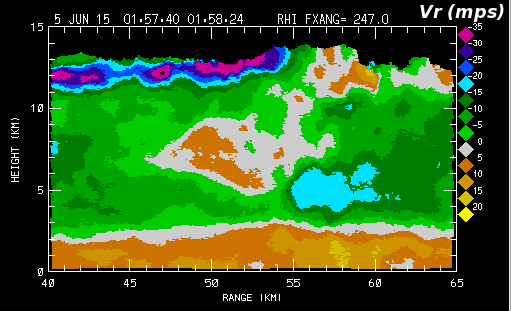
Selected dual polarization fields from this RHI scan have been collected into the following image loop sequence. Instead of a continuous animation, it is recommended that the "next" button be used to step through the images. The CSU-CHILL polarimetric data was collected using the alternating polarization mode (H polarized pulse followed by a V polarized pulse) vs. the VHS method employed by KFTG. This alternating operating mode is not affected by cross coupling. The CHILL Zdr field is relatively featureless in the sub-freezing portions of the echo. The effects of the oriented ice crystals are masked by the larger diameter, higher reflectivity, quasi-spherical (~0 dB Zdr) aggregated ice particles. In contrast to Zdr, specific propagation differential phase is sensitive to the presence of oriented, non-spherical hydrometeors. As the mean ice crystal orientation becomes quasi-vertical due to electric field effects, the propagation of the V waves is slowed relative to the H wave speed. This difference leads to the fractionally negative Kdp values that were observed above ~ 6 km AGL. Enhanced Linear Depolarization Ratio (LDR) values were detected at somewhat greater heights (i.e., above ~8.5 km AGL). LDR is maximized when the hydrometeor's major axis is rotated to 45 degrees since this angle most effectively backscatters incident H waves into the V cross=polar polarization.
